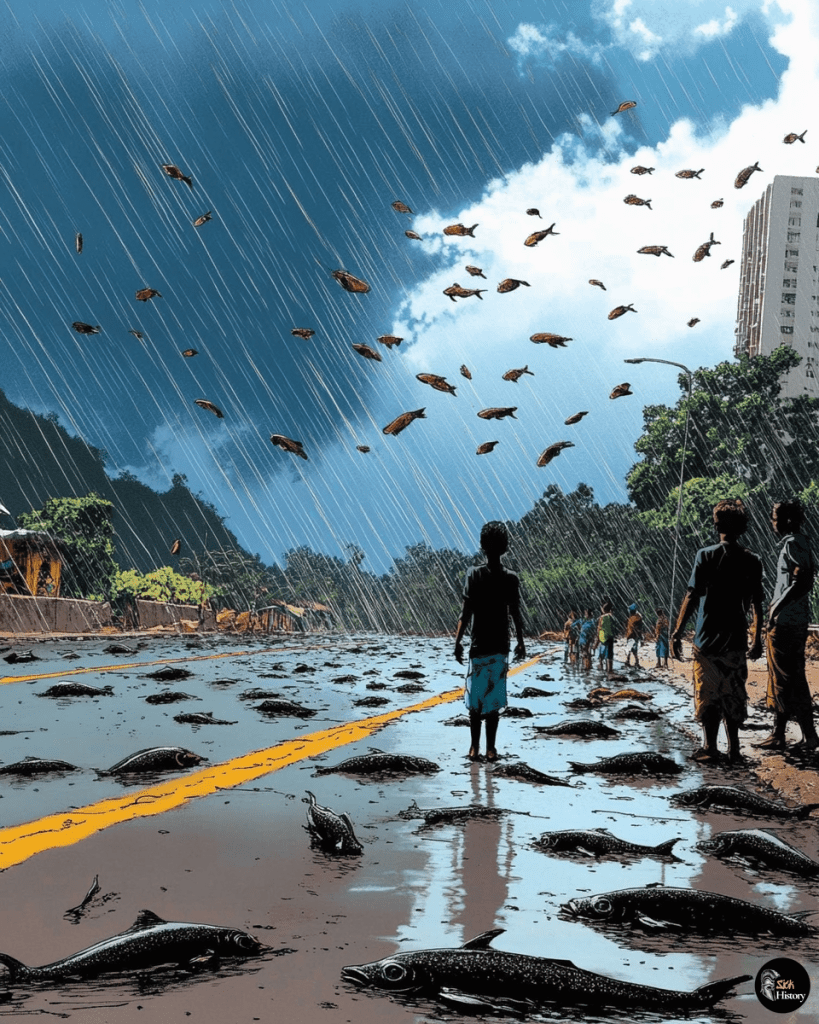In the small town of Yoro, Honduras, a peculiar phenomenon has captivated locals and visitors alike for over a century. Known as “lluvia de peces” or “rain of fish,” this event reportedly occurs multiple times a year, with small silver fish seemingly falling from the sky during heavy rainstorms.
The “rain of fish” phenomenon in Yoro, Honduras involves fish apparently falling from the sky during storms, typically occurring up to four times annually.
While some attribute this occurrence to divine intervention, scientists propose more earthly explanations.
One theory suggests that waterspouts or tornadoes may lift fish from nearby bodies of water and deposit them on land.
The legend of the fish rain gained prominence in the mid-19th century when Spanish missionary Father Jose Manuel Subirana visited Yoro.
According to local lore, Subirana prayed for three days and nights to alleviate the poverty and hunger of the region’s inhabitants. His prayers were supposedly answered with the miraculous rain of fish, providing sustenance for the people.
Phenomenon of Lluvia de Peces
The Lluvia de Peces, or “rain of fish,” is a mysterious occurrence in Yoro, Honduras where fish reportedly fall from the sky. This phenomenon has captured local and international attention, sparking various explanations and cultural significance.
Scientific Explanations
Scientists have proposed several theories to explain the Lluvia de Peces.
One popular explanation involves waterspouts or tornadoes.
These powerful weather events might pick up fish from nearby bodies of water and deposit them on land during rainstorms. The fish could come from rivers, streams, or even the Atlantic Ocean.
Another theory suggests that the fish are not actually falling from the sky. Instead, they may emerge from underground water sources during heavy rains, giving the illusion of raining fish.
Some experts believe strong winds might carry the fish from distant water bodies.
Cultural Significance in Yoro
The Lluvia de Peces is very important to the people of Yoro. It has become part of their cultural identity and local folklore.
The event attracts tourists and researchers, boosting the local economy. Many residents view it as a blessing, providing food during times of scarcity.
Yoro celebrates the phenomenon with an annual festival called Festival de la Lluvia de Peces. This celebration includes parades, music, and the collection of fish.
The event has also inspired local art and literature, further cementing its place in Honduran culture.
Meteorological Perspective
Meteorological factors play a crucial role in explaining the fish rain phenomenon in Honduras. Weather patterns and atmospheric conditions contribute to this unusual occurrence, with waterspouts being a key element in the process.
Waterspouts and Weather Patterns
Waterspouts are among the most plausible explanations for the fish rain in Yoro, Honduras.
These rotating columns of air can form over bodies of water, sucking up small aquatic life. When waterspouts move inland, they may deposit their cargo, including fish, onto land.
The geographical location of Yoro, situated between mountains and the Atlantic Ocean, creates unique weather conditions.
Strong winds and sudden temperature changes can contribute to waterspout formation, which typically occurs during storms or periods of atmospheric instability.
Comparative Analysis With Similar Phenomena
Fish rain is not unique to Honduras. Similar events have been reported in other parts of the world.
For example, small fish have been known to fall during monsoon rains in India. Meanwhile, Australia has also experienced instances of fish falling from the sky.
These occurrences share common meteorological factors:
- Proximity to large bodies of water
- Sudden changes in air pressure
- Strong updrafts capable of lifting small objects
Scientists studying these events note that the fish species involved are usually small and lightweight. This characteristic makes them more susceptible to being carried by strong air currents.
The frequency and predictability of the Lluvia de Peces in Honduras make it a particularly intriguing case for meteorologists and researchers.

